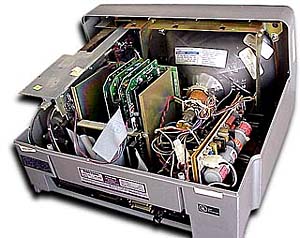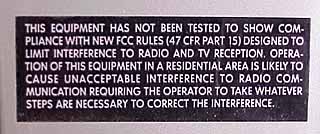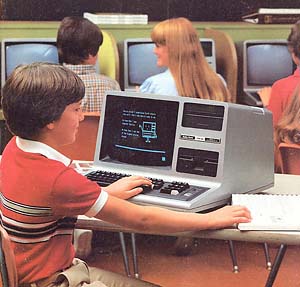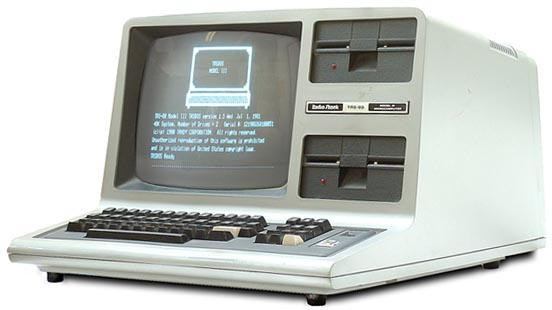|
Introduction to TRS-80 In the spring of 1977, I received a phone call
from Ben Rosen, who at that time was a market analyst for Morgan Stanley.
He was just about the only stock market analyst specializing in the infant
personal computer industry and one of the industry experts. Ben, who later
became the Chairman of both Compaq and Lotus, had already organized the first
of his famous industry seminars, and he had invited me on a panel as a
retailer. This call, however,
was to tell me that I was about to receive a visit from an important
person, if I had time to see and talk with him today. Ben went on to tell
me that my visitor would be Charles Tandy, who owned the Radio Shack chain
of some 7,000 stores. He had only that day, and he wanted to visit a
successful computer store. Mr. Tandy arrived shortly after lunch and
introduced himself. "Call me Charles," he said as I conducted him
through my operation. We started in the basement where we repaired
computers, built many of them into systems, and had our stock room. Then
to the selling floor, where he seemed most interested in the Apple II and
the SOL. Charles was a man who could put anyone at ease, even if they knew
how important a person he was. He had the knack of asking the most direct
and revealing questions in a way that aroused no resentment. I really
enjoyed talking with him, flattered that this powerful businessman would
seek me out for advice. At the end of the day, he told me that he had visited other computer
stores and in general classified them into two categories: first, stores
run by computer hobbyists where a neophyte would be ignored, or snowed.
The second type of store was run by ex-used car salesmen who were masters
of the hard sell. They tried to completely snow the average prospective
buyer. He said my store did not fit into either category (for which I was
grateful,) but seemed to meet the customer at whatever level they were at.
I told Charles that most of my salespeople were recruited from the
hobbyist ranks, but that I had trained them somewhat in the art of retail
selling. We talked all afternoon, and at the end of the day
he asked what I was doing that weekend, and would I consider going back
with him to his headquarters in The next morning was Friday, and I met the Tandy
party in their suite at the Hotel Carlisle on All this was new and exciting to me. I had never
flown in a corporate jet, and I had never been to
With that, they showed me what seemed to be a
keyboard and a 12-inch TV screen, with a wire connecting the two units.
The plastic case was colored with a
metallic silver gray finish, and the keyboard and front of the TV was
a contrasting black. The oversized logo on the front read "RADIO SHACK
TRS-80" and "MICRO COMPUTER SYSTEM." My first comment was, "Where's the computer?" "It's inside the keyboard case," I was told.
"Right under the
keyboard!" I could hardly believe it.
I was used to the Altair and Imsai_even the SWTPC 6800 and the SOL with their brute
force power supplies and expandable bus. Even the Apple II, which I
considered a masterpiece of compact design, took much more space than the
TRS-80 keyboard unit. Then I
noticed the external power supply plugged into the wall. Well, there was
one reason for the size. "We decided to use an external power supply to
conserve space and keep the heat out of the computer case.
"Okay," I thought. That made sense.
I really liked the idea that the TRS-80 came
with its own TV monitor. In those days video monitors were very hard to
get and they were expensive. I
had bought a huge order of 9-inch, high quality, security type video
monitors to sell with my computers, and I sold them at a very small
mark-up if the customer bought a computer. Radio Shack had provided a 12-inch TV quality
video display that was really a television with the radio section removed.
This was a smart way to get a larger, reasonably priced video monitor if
you had the buying power of Tandy. "Tell me some more about the computer?" I
asked. "Well," someone answered, "it's a Z-80 based
machine with 4K of RAM, and a ROM with the boot-up software and BASIC.
Programs and data are loaded through a cassette. The video display has 64
characters and 16 lines and there are graphics characters as well as
uppercase letters." "This is interesting," I thought. "Just like
the first Apple I." "Tell me about the BASIC?" I asked.
"Well, it's out. Level I contained in a
By now I was very impressed with the TRS-80,
and I fully realized that it was going to be hard competition for anything
I sold, except possibly the Apple II. The big question in my mind was, how much would they sell it for?
As if he was reading my mind, Charles asked me,
"How much do you think should I sell it for?" I really had no basis of comparison except
possibly the SOL (I had not received an Apple II yet,) and it sold for
$1,400 with a video monitor. Well, this machine is a lot simpler, so I
should figure about $1,000. However this is Radio Shack so it must be
cheaper. I'll say $900. "Well," I said, "about $900 would be a fair
price."
"What would you think about $600?" one of the
Tandy people answered.
"If you are going to sell this system with a
video display and built-in BASIC for $600, you better build a hell of a
lot of them," I returned. "Stan, just how many do you think would be
enough?" one of the Tandy people asked. "Enough," I said, "would be about 50,000." "You are out of your mind," answered one of
Tandy's staff. "No one has ever
built more than 5,000 of the same type of computer, and we are thinking
12,000."
"You have 7,000 stores," I returned. "If you
have only one to show and one to sell, that's no way for a big company
to do business."
"We don't think all of our stores can sell
computers; it's a specialized business." "True," I answered, "but this computer may
change all that." After this exchange, I sensed a division in the
company. Charles and all the people he had brought on board to develop the
TRS-80 were convinced that the TRS-80 would be a tremendous success and
would change their business. The older electronics people whose thinking
was fixed in the audio, radio, and hobby electronics business did not
understand the fascination of the computer for even the most conservative
business person. Charles then showed me folders containing
cassettes and manuals for all kinds of home and business software. There were accounting programs, home
management programs, and educational programs. They were all going to sell
for less than $30.
At this I smiled and said, "Keeping business
records on a tape cassette program has not proved very practical. (I was being very kind!) You would be well advised to keep
your programs very simple until you get a disk-based system."
They ignored me and changed the subject. "How
many of these computers could you sell in your store?"
"I would start with 10 per week and end up
selling 40 or 50 a week," I replied. They obviously did not believe me, but they
didn't challenge my statements. The meeting broke up at that point, and I was
taken to a hotel to freshen up for some About Then Charles told me how he had started in
business making leather hobby kits and selling them in his craft stores.
How he had bought the failing Radio Shack company, which was a retail electronics distributor
that had evolved from ham radio equipment. He had built Radio Shack into
the world's largest electronic retailer and one of the largest
distributors in the After we left the construction of
When I returned to
They said. "Do what you think best." My partner, Mike Alpert, said that as long as he
got back his investment and some return, he would go along with anything I
wanted to do. So the decision was mine alone to make. One thing bothered
me about this sale, and I called to talk it over with Charles Tandy. When I started the store in 1976,
I did not draw any salary for a full year. We lived on my wife's salary as
a
|
| Level II
BASIC
The development of Level II BASIC gave the TRS-80 its first real chance to make good on all the promises Radio Shack had been making to the public. This vastly improved language was able to be used for business and home applications. Most of the computers were Level II, but those who had bought the original Level I machines could have their machines upgraded for $120. Video games started to appear using the graphics characters, and the stock of available cassettes in all categories increased. By 1978, semiconductor technology had advanced to the point where 16K memory chips had come down in price, and it was possible to offer an upgrade to the TRS-80. This removed the original memory chips and replaced them with new 16K RAM. Many users had this upgrade done when they had Level II BASIC installed. It was quite expensive to have Radio Shack make the upgrade and several small companies came out with do-it-yourself upgrade kits. These sold for about $140, about half the price of the Radio Shack installation, and many users bought the kits, opened their case for the first time, and installed their own RAM. By 1976, Radio Shack was selling the Level II, 16K TRS-80 for $849. This included a numeric keypad, a 6K RAM, and the 12K ROM containing the Level II BASIC. The enhanced BASIC included such features as string handling, multi-dimensional arrays, and multi-letter variable names (Level I only had two letter variable names.) You could name cassette files, and full editing was supported. Since BASIC came in a 12K ROM, the entire 16K was available for user programs. In 1979, this was a huge amount of available memory. The TRS-80 was equal to a 28K system, and it was hard to imagine that anyone would ever need more than THAT! |
| The Expansion
Unit and Disk Drives
The tape cassette had been considered a great improvement over paper tape for storing programs and data for personal computers, but soon it became apparent that it was not a satisfactory solution as a data storage medium. The serial transfer rate was too slow, and the method of converting digital data into audio frequencies for recording was subject to error. The inexpensive tape cassettes, designed for audio, were prone to failure and tape stretch that rendered them unreadable. The S-100 computers were adopting floppy disk storage. Eight inch diskettes and the recently-invented 5 1/2-inch mini-floppies were coming into use. Apple Computer was selling their 5 1/2-inch disk drives for the Apple II as fast as they could make them. For Radio Shack to develop a disk drive system, a major system unit had to be designed and manufactured. This was the Expansion Interface, a unit that could be mounted under the Video Display. It contained the RAM expansion_up to 32K could be installed. It also provided a real-time clock, serial interface, printer port, and, most importantly, the disk controller. The controller could support up to four floppy disk drives. The TRS-80 Mini Disk System used a diskette with a capacity of 83K formatted. The disk with the operating system on it had 53K remaining. There were 35 tracks per disk with 2500 bytes per track, divided into ten sectors. Data could be moved in or out of the disk at a rate of 12.5 Kbytes per second, a great improvement over tape cassettes. The operating system, TRSDOS, had to be on the first drive for the system to operate. |
| TRSDOS - the
Radio Shack Operating System
The dominant disk operating system for 8080 and Z-80 CPU's was CP/M. It was used by almost all of the manufacturers of this type of computer, and therefore a considerable library of software had developed for CP/M systems. It was considered the standard for this type of computer. Radio Shack chose to ignore the standard and develop their own operating system. It was more important for them to completely control their system than make a considerable stock of programs available to Radio Shack owners. In fact, Radio Shack made it impossible to run the standard CP/M on a TRS-80 computer by preempting certain entry points on the memory map. Since these points were in the system ROM, it was impossible to change them. As a result, TRSDOS developed on its own. While it was possible to port many CP/M programs to TRSDOS, it was a task for an expert and required a rework of the program. In time, TRSDOS came to have as a big a library of software as CP/M and as much support among software publishers. There were several versions of TRSDOS, including some produced by third-party software developers, which were compatible, but included features not found in Radio Shack's versions. Eventually there were versions of CP/M that could be run on the TRS-80. These were not compatible with standard CP/M, and programs had to be specially configured to run on them. |
The Model III
TRS-80 System
At the end of 1979, there were over a million personal computers operating in the United States. In fact, it was possible that over a million TRS-80s alone were sold. Radio Shack has never released the figures. One result of this was a marked increase in television interference in homes. A computer in operation generates AC interference at radio frequencies. This can be broadcast through the air, or transmitted through the power lines. It is the job of the FCC to regulate electronic equipment to see that these emissions do not interfere with communications. They have a massive job to do, and by 1978, a large number of complaints were being received. The FCC published regulations covering personal computers and expected the manufacturers to comply. Most of the computers at that time were housed in metal cabinets which shielded them and made it easy to comply with the FCC regulations. Two computers were housed in plastic cabinets and they could not meet the FCC Regulations. These were the Apple II and the TRS-80 Model I. Apple managed to gain approval by coating the inside of the cabinet with a metallic finish and shielding the cable openings. Radio Shack, however, could not make the TRS-80 Model I meet FCC regulations because of the separate units and the cable connections between them. As a result, they accomplished a complete redesign of the TRS-80 into a completely self-enclosed desk top cabinet. This was called the TRS-80 Model III. First ready in July 1980, in its cassette version it sold for $699 and incorporated many features that had been included in the Expansion Interface. The Model III had a 12-inch screen, which displayed the standard 96-character ASCII set with both upper and lower case characters. It also displayed 64 graphics characters and 160 special TRS-80 characters. The keyboard provided for entry of all the standard characters, including upper and lower case. There was also a 12-key numeric keypad. The Model III used the Z-80 CPU and from 16K to 48K of RAM. A parallel printer port was provided. Data storage was provided by either cassette or an optional floppy disk controller, and up to two internally mounted floppy disk drives. Additionally, two external floppy disk drives could be connected into the system. There was an option for installation of an RS-232C port for connection to a modem. Model III BASIC and MODEL III TRSDOS were improved over Model I, but care was taken to make Mode III software compatible with Model I. If this proved impossible, conversion programs were often provided. The TRS-80 Model III was one of the most successful computers ever built. It was used in schools throughout the United States, replacing the failing Commodores. It was used in offices, factories, and homes. By 1983, when it was replaced by the Model 4, a couple of million must have been sold. (Radio Shack has never given out the figures.) It was supported by the largest software libraries in existence up to that time, and several other operating systems were written for it. It became the standard grade school computer in thousands of school districts and the mainstay of small business. TRS-80 Model 4 The TRS-80 Model 4 was the best of the mark and included many improvements that should have been made to the Model III during its years of manufacture. The Model 4 was probably the best 8-bit, Z-80 computer ever built. Unfortunately it came out too late, and had to compete with the IBM PC/XT and the onslaught of the clones. It remained in the catalog for a long time as a replacement for Model III's in schools and offices where they did not wish to lose their investment in software. The most striking thing about the Model 4 was its white color. Charles Tandy had selected the metallic silver and gray colors, and after he died nobody in the company wanted to change it. To the outside world it looked old-fashioned and brought to mind the "Trash-80" image that competitors had tagged the TRS-80 with. Finally, they caught up with the times and made the necessary changes. For the first time, the TRS-80 had an 80-column by 24-line screen, with an option to display high resolution graphics. The memory was expanded to 64K with an option to increase it to 128K. The disk drives were double density (184K,) and the keyboard was a full function with three programmable function keys. The operating system for the Model 4 was TRSDOS 6, which had been developed from LDOS, one of the independent operating systems. In addition, for the first time, standard CP/M was available for use on The TRS-80. Microsoft BASIC 2.0 was provided as the main language. The Model 4 was designed to be compatible with the Model III. However, when operating with Model III software, the video display was 64-characters by 16-lines and the 48K memory restriction applied. The Z-80, which operated at 4 MHz as a Model 4, only ran at 2 MHz in Model III mode. Radio Shack also introduced a portable version of the Model 4 called the Model 4P. This had a 9-inch CRT and two disk drives in a portable case.
An Evaluation of the TRS-80 Computers. The TRS-80 family of computers has never received the credit they deserved as a cornerstone of the personal computer era. Mainly this is the fault of the Tandy Corporation, who failed to understand the importance of public relations in the development of a booming industry. While more TRS-80 computers were built and sold than any other kind, all the attention went to Apple, IBM, and even the small CP/M based machines, which never came close to TRS-80 in popularity and customer satisfaction. Perhaps much of this was due to Tandy/Radio Shack's position as both manufacturer and retailer. They did not have to fight for shelf space in stores and woo the value-addled resellers. In addition, much of the TRS-80 sales went to schools and small businesses in the hinterlands of the U.S.A. Not many major corporations were willing to trust their data processing to a "Trash-80" built by Radio Shack, no matter how good the technical people said it was. It was only when IBM made personal computers "respectable" did the data processing departments admit that there might be some value in these little computers.
|
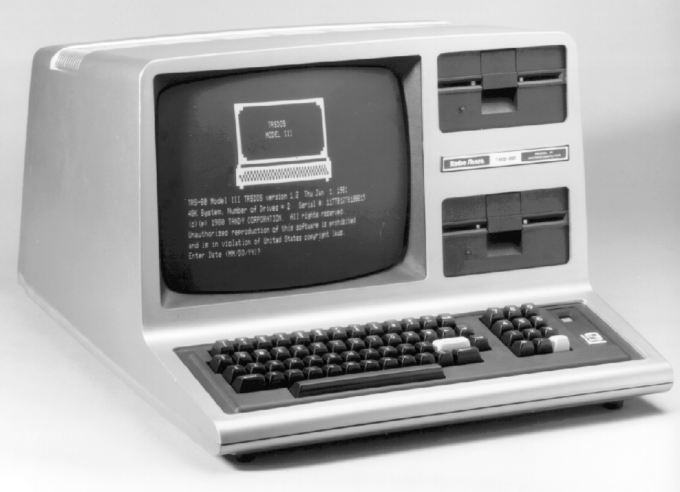
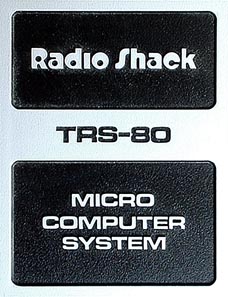
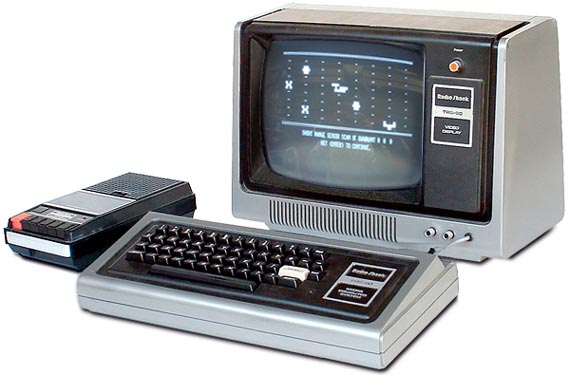
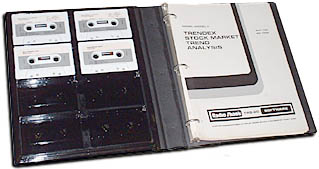
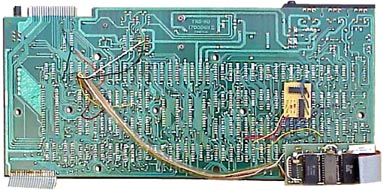
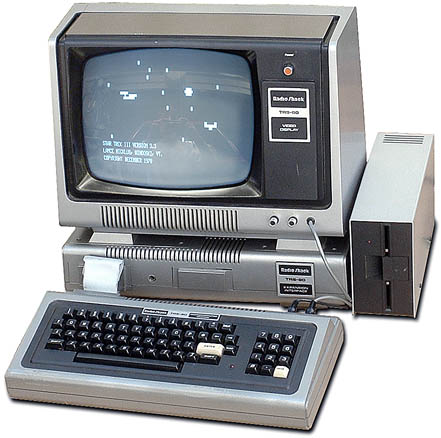 Most serious
users eventually purchased the $299 Expansion Interface, a well-designed and
attractive external module which sits under the monitor.
Most serious
users eventually purchased the $299 Expansion Interface, a well-designed and
attractive external module which sits under the monitor. 
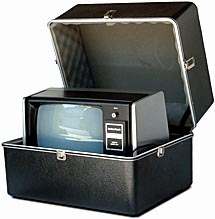
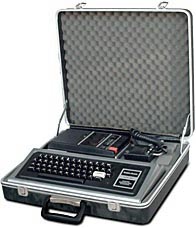
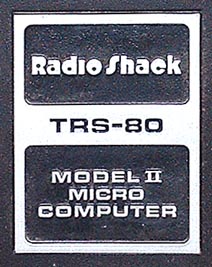
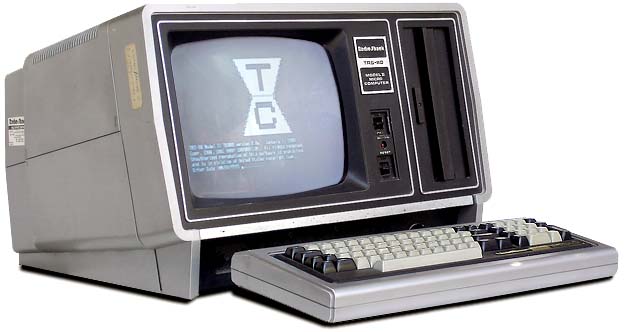
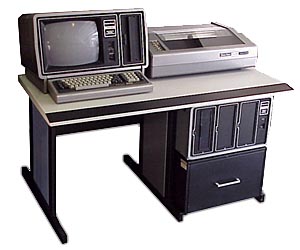 Also available is
the matching computer desk and a high-performance line-printer. The desk
includes a pull-out storage drawer, and the Disk Expansion Unit with space for
three additional 8-inch floppy drives.
Also available is
the matching computer desk and a high-performance line-printer. The desk
includes a pull-out storage drawer, and the Disk Expansion Unit with space for
three additional 8-inch floppy drives. 